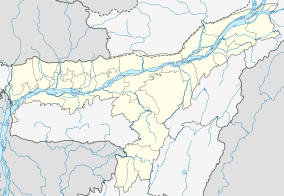You can help expand this article with text translated from the corresponding article in Assamese. (January 2013) Click for important translation instructions.
|
| Pobitora Wildlife Sanctuary | |
|---|---|
| IPA: [ˈpəʊbɪˌtɔ:rə] | |
 Indian rhinoceros in Pobitora Wildlife Sanctuary Indian rhinoceros in Pobitora Wildlife Sanctuary | |
 | |
| Location | Morigaon, Assam |
| Nearest city | Guwahati |
| Coordinates | 26°14′28″N 92°03′30″E / 26.24111°N 92.05833°E / 26.24111; 92.05833 |
| Area | 38.85 km (15.00 sq mi) |
| Established | 1987 |
| www | |
Pobitora Wildlife Sanctuary is a wildlife sanctuary on the southern bank of the Brahmaputra in Morigaon district in Assam, India. It was declared in 1987 and covers 38.85 km (15.00 sq mi), providing grassland and wetland habitat for the Indian rhinoceros. It holds one of the largest Indian rhinoceros population in Assam.
Biodiversity

Pobitora Wildlife Sanctuary's grassland vegetation consists of at least 15 grass species including Cynodon dactylon, whip grass (Hemarthria compressa), vetiver (Chrysopogon zizanioides), ravennagrass (Saccharum ravennae), Phragmites karka, southern cutgrass (Leersia hexandra) and signalgrass (Brachiaria pseudointerrupta). The grasslands provide habitat and food resource for the Indian rhinoceros, hosting Assam's second largest population. Other mammals occurring in the sanctuary are golden jackal, wild boar and feral water buffalo. Barking deer, Indian leopard and rhesus macaque live foremost in the hilly parts. It is an Important Bird Area and home for more than 2000 migratory birds and various reptiles.
References
- ^ Konwar, P.; Saikia, M. K. & Saikia, P. K. (2009). "Abundance of food plant species and food habits of Rhinoceros unicorns Linn. in Pobitora Wildlife Sanctuary, Assam, India". Journal of Threatened Taxa. 1 (9): 457–460. doi:10.11609/JoTT.o1640.457-60.
- Choudhury, A. U. (1985). "Distribution of Indian one-horned rhinoceros". Tigerpaper. 12 (2): 25–30.
- Choudhury, A. (2005). "Threats to the greater one-horned rhino and its habitat, Pabitora Wildlife Sanctuary, Assam, India". Pachyderm. 38: 82–88.
- Islam, Z.; Rahmani, A. (2004). IBAs in India. Mumbai and Cambridge: Bombay Natural History Society and Birdlife International.
